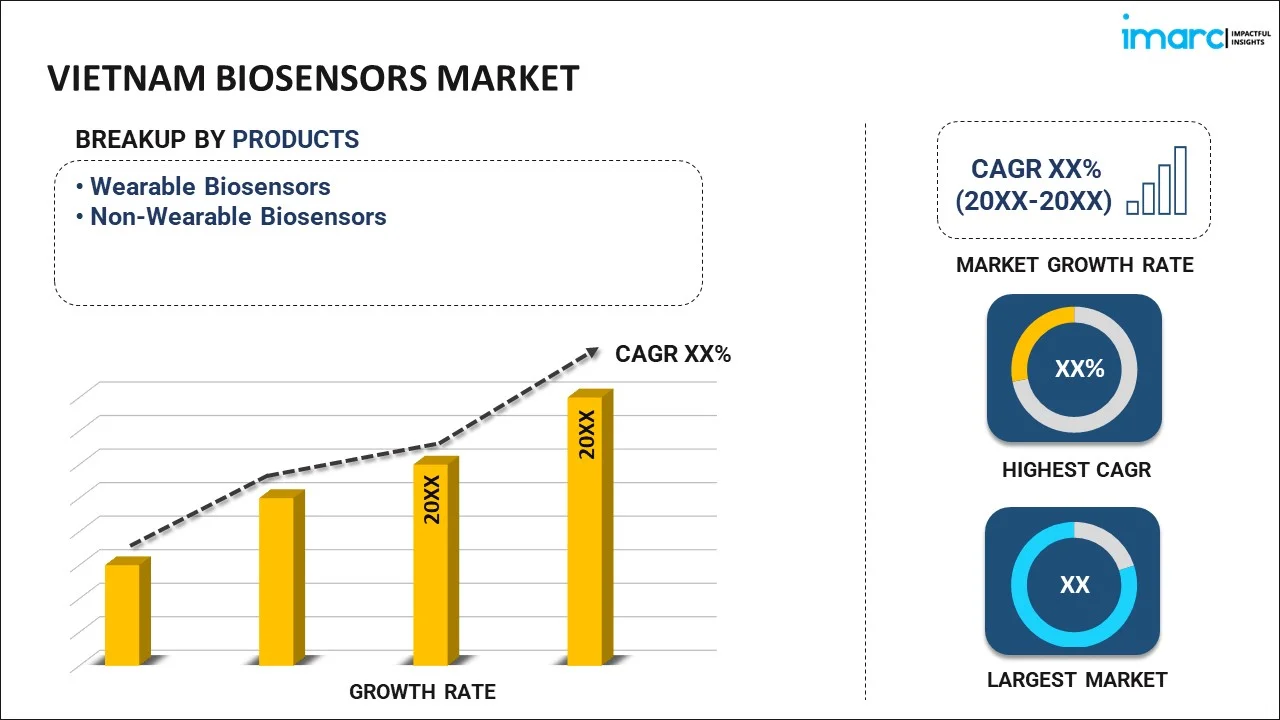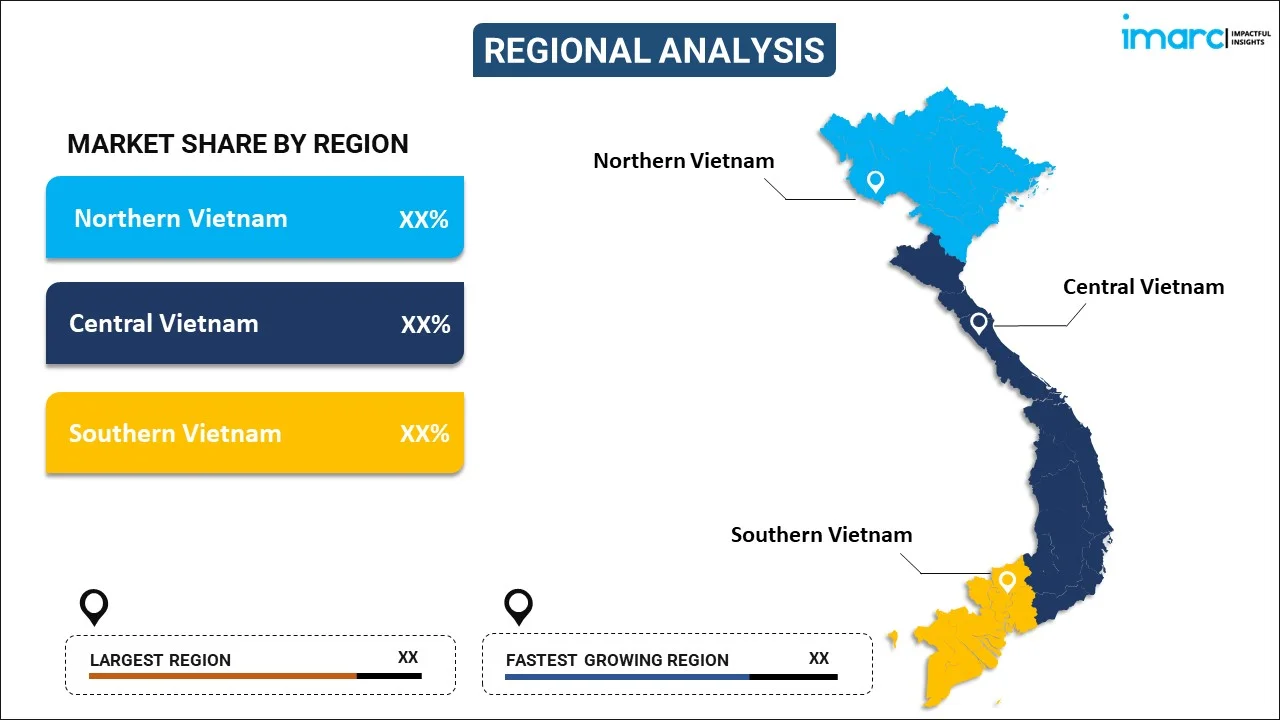
Vietnam Biosensors Market Report by Product (Wearable Biosensors, Non-Wearable Biosensors), Technology (Electrochemical Biosensors, Optical Biosensors, Piezoelectric Biosensors, Thermal Biosensors, Nanomechanical Biosensors, and Others), Application (Blood Glucose Testing, Cholesterol Testing, Blood Gas Analysis, Pregnancy Testing, Drug Discovery, Infectious Disease Testing, and Others), End Use (Point of Care Testing, Home Healthcare Diagnostics, Research Laboratories, Security and Biodefense, and Others), and Region 2025-2033
Market Overview:
Vietnam biosensors market size reached USD 123.6 Million in 2024. Looking forward, IMARC Group expects the market to reach USD 218.4 Million by 2033, exhibiting a growth rate (CAGR) of 6.53% during 2025-2033. Continuous advancements in the medical industry, along with the enhancements in healthcare infrastructures, are primarily driving the market growth.
|
Report Attribute
|
Key Statistics
|
|---|---|
|
Base Year
|
2024
|
|
Forecast Years
|
2025-2033
|
|
Historical Years
|
2019-2024
|
|
Market Size in 2024
|
USD 123.6 Million |
|
Market Forecast in 2033
|
USD 218.4 Million |
| Market Growth Rate 2025-2033 | 6.53% |
A biosensor, also known as a biological sensor, is an analytical device employed to identify alterations in diverse biological processes and translate them into an electrical signal. It serves the purpose of monitoring various biological components, such as enzymes, nucleic acids, tissues, cell receptors, microorganisms, and antibodies. Some of the commonly utilized biosensors encompass mass, optical, electrochemical, magnetic, nanomechanical, thermometric, acoustic, and immunosensors. These biosensors typically comprise a responsive sensor, a transducer, a microcontroller, a signal conditioning circuit, and a display unit. They find integration in various devices such as resonant mirrors, chemical canaries, optodes, bio-computers, biochips, and glucometers. Biosensors have broad applications across point-of-care (POC) diagnostics, research endeavors, environmental monitoring, and biodefense-related purposes.
Vietnam Biosensors Market Trends:
The robust expansion of the medical industry worldwide is a primary driver contributing to the favorable prospects of the Vietnam biosensors market. Furthermore, the extensive adoption of wearable biosensors for continuous monitoring of vital signs among a wide range of individuals, including patients, infants, children, athletes, and fitness enthusiasts, is significantly propelling market growth. These biosensors enable remote monitoring and real-time transmission of biological data to healthcare professionals, facilitating timely interventions. They are also integrated into smart textiles, allowing for the convenient tracking of vital signs. Additionally, with the ongoing spread of the coronavirus disease (COVID-19), there has been a substantial surge in demand for biosensors in healthcare centers to continuously monitor patients' health conditions. Moreover, various technological advancements are playing a pivotal role in market growth. These include the integration of connected devices with the Internet of Things (IoT) and the development of innovative nanotechnology-based biosensors. Such biosensors are effectively employed in nanotubes, nanowires, nanorods, and nanoparticles for biomolecular detection. Other factors contributing to market expansion encompass notable enhancements in healthcare infrastructure and extensive research and development (R&D) activities, both of which are expected to continue driving the market forward in the coming years.
Vietnam Biosensors Market Segmentation:
IMARC Group provides an analysis of the key trends in each segment of the market, along with forecasts at the country level for 2025-2033. Our report has categorized the market based on product, technology, application, and end use.
Product Insights:

- Wearable Biosensors
- Non-Wearable Biosensors
The report has provided a detailed breakup and analysis of the market based on the product. This includes wearable biosensors and non-wearable biosensors.
Technology Insights:
- Electrochemical Biosensors
- Optical Biosensors
- Piezoelectric Biosensors
- Thermal Biosensors
- Nanomechanical Biosensors
- Others
A detailed breakup and analysis of the market based on the technology have also been provided in the report. This includes electrochemical biosensors, optical biosensors, piezoelectric biosensors, thermal biosensors, nanomechanical biosensors, and others.
Application Insights:
- Blood Glucose Testing
- Cholesterol Testing
- Blood Gas Analysis
- Pregnancy Testing
- Drug Discovery
- Infectious Disease Testing
- Others
The report has provided a detailed breakup and analysis of the market based on the application. This includes blood glucose testing, cholesterol testing, blood gas analysis, pregnancy testing, drug discovery, infectious disease testing, and others.
End Use Insights:
- Point of Care Testing
- Home Healthcare Diagnostics
- Research Laboratories
- Security and Biodefense
- Others
A detailed breakup and analysis of the market based on the end use have also been provided in the report. This includes point of care testing, home healthcare diagnostics, research laboratories, security and biodefense, and others.
Regional Insights:

- Northern Vietnam
- Central Vietnam
- Southern Vietnam
The report has also provided a comprehensive analysis of all the major regional markets, which include Northern Vietnam, Central Vietnam, and Southern Vietnam.
Competitive Landscape:
The market research report has also provided a comprehensive analysis of the competitive landscape in the market. Competitive analysis such as market structure, key player positioning, top winning strategies, competitive dashboard, and company evaluation quadrant has been covered in the report. Also, detailed profiles of all major companies have been provided.
Vietnam Biosensors Market Report Coverage:
| Report Features | Details |
|---|---|
| Base Year of the Analysis | 2024 |
| Historical Period | 2019-2024 |
| Forecast Period | 2025-2033 |
| Units | Million USD |
| Scope of the Report | Exploration of Historical and Forecast Trends, Industry Catalysts and Challenges, Segment-Wise Historical and Predictive Market Assessment:
|
| Products Covered | Wearable Biosensors, Non-Wearable Biosensors |
| Technologies Covered | Electrochemical Biosensors, Optical Biosensors, Piezoelectric Biosensors, Thermal Biosensors, Nanomechanical Biosensors, Others |
| Applications Covered | Blood Glucose Testing, Cholesterol Testing, Blood Gas Analysis, Pregnancy Testing, Drug Discovery, Infectious Disease Testing, Others |
| End Uses Covered | Point of Care Testing, Home Healthcare Diagnostics, Research Laboratories, Security and Biodefense, Others |
| Regions Covered | Northern Vietnam, Central Vietnam, Southern Vietnam |
| Customization Scope | 10% Free Customization |
| Post-Sale Analyst Support | 10-12 Weeks |
| Delivery Format | PDF and Excel through Email (We can also provide the editable version of the report in PPT/Word format on special request) |
Key Questions Answered in This Report:
- How has the Vietnam biosensors market performed so far and how will it perform in the coming years?
- What has been the impact of COVID-19 on the Vietnam biosensors market?
- What is the breakup of the Vietnam biosensors market on the basis of product?
- What is the breakup of the Vietnam biosensors market on the basis of technology?
- What is the breakup of the Vietnam biosensors market on the basis of application?
- What is the breakup of the Vietnam biosensors market on the basis of end use?
- What are the various stages in the value chain of the Vietnam biosensors market?
- What are the key driving factors and challenges in the Vietnam biosensors?
- What is the structure of the Vietnam biosensors market and who are the key players?
- What is the degree of competition in the Vietnam biosensors market?
Key Benefits for Stakeholders:
- IMARC’s industry report offers a comprehensive quantitative analysis of various market segments, historical and current market trends, market forecasts, and dynamics of the Vietnam biosensors market from 2019-2033.
- The research report provides the latest information on the market drivers, challenges, and opportunities in the Vietnam biosensors market.
- Porter's five forces analysis assist stakeholders in assessing the impact of new entrants, competitive rivalry, supplier power, buyer power, and the threat of substitution. It helps stakeholders to analyze the level of competition within the Vietnam biosensors industry and its attractiveness.
- Competitive landscape allows stakeholders to understand their competitive environment and provides an insight into the current positions of key players in the market.
Need more help?
- Speak to our experienced analysts for insights on the current market scenarios.
- Include additional segments and countries to customize the report as per your requirement.
- Gain an unparalleled competitive advantage in your domain by understanding how to utilize the report and positively impacting your operations and revenue.
- For further assistance, please connect with our analysts.
 Inquire Before Buying
Inquire Before Buying
 Speak to an Analyst
Speak to an Analyst
 Request Brochure
Request Brochure
 Request Customization
Request Customization




.webp)




.webp)












